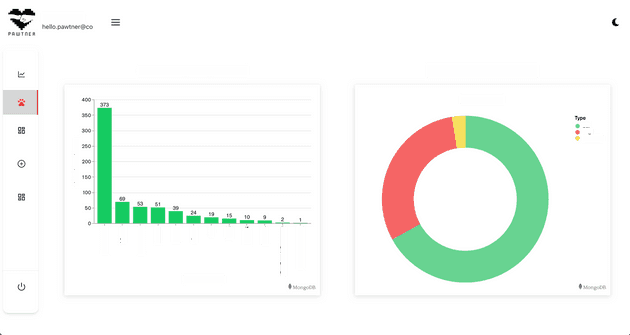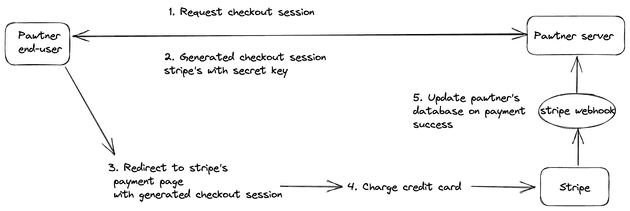For 1.5 years, I worked for pawtner as technical lead with other 5 developers. It has been a very long journey since scratching ideas to the moment, that the app is officially available on google play and app store. This blog post isn’t about the app, but how we built it at pawtner. There’s too much to dive deep in a single post, so with this post, I just want to make a retrospection and give you the overview of technologies, programming languages or services that we used.
Technology overview
Here are the primary technologies used for this project:
- MongoDB: No SQL database
- React Native: for building cross platform app using react
- Typescript: Typed javascript
- React Query: a powerful library for handling server state in react
- MSW: fantastic tool for mocking HTTP requests in the browser/node
- ASP.NET: web framework to build web app with C#
- Express: Node server framework
- Apollo server: for building graphql server
- Redis: In-memory database–key/value store.
- GraphQL: A query language for API (GraphQL is not 100% used at pawtner)
- Docker: to containerize your application
Here are the primary services used at pawtner:
- Azure: cloud services from microsoft
- Firebase: a platform developed by Google. Firebase is used for multiple important features: authentication, real time update, hosting,…
- Expo: a platform that makes app-development with react native easier
- Stripe: a financial service that offers online payment processing
- SendGrid: an email delivery service
Database
I’m not going into the battle between SQL and no-SQL databases. Both them have their advantages and trade-off. SQL databases is always my personal preference, but in pawtner MongoDB is the more suitable candidate because of its flexibility. We shipped out new features every month, the requirements change frequently so does the database schema, that’s why MongoDB is our primary database.
For the data, that we retrieve or check frequently such as session tokens and user permissions we also need an intermediary data store. For this purpose, we use Redis.
Data visualization
For a young and growing product, analyzing data and end’s user behavior plays an important role both in marketing and designing new features. Because I don’t have experience with any business intelligence tool like PowerBI, Tableau,.. I need a simple, straightforward solution for developers, with that my database knowledge can be easily applied. MongoDB Charts proved to be the perfect solution for our use cas. With MongoDB Charts we can write your own queries or even aggregation pipelines and then generate multiple charts easily. Here’s a basic example how we used MongoDB Charts to visualize our data at pawtner.

Frontend framework: React Native
React native + typescript might be the wisest decision we made at pawtner. As a react developer, you will not have too much difficulties to get started with react native. All your valuable knowledge in react: jsx, components and props, hooks,… will be the same in react native. Instead of web api, you have to learn some new APIs for mobile devices and React Native’s documentation is a perfect resource to learn them.
React query
After a quite long time getting frustrated with the finding for the right tool for state management in react, react query will become my friend. It’s important to separate your application’s state into server state and client state. React query is a powerful library to handle fetching, caching, synchronizing and updating server state. With the help of this library, our client state can be handled with React’s Context and useState without installing any other external library. The only minus point for this library is the usage with graphql is not straightforward as other graphql clients such as Apollo client or urql
Mocking API with MSW
When I’m developing locally, besides MongoDB and redis databases running with docker, I also have to interact with third-party APIs. Currently pawtner is working with a tons of external APIs, for example:
- Stripe checkout: to create payment flow
- Azure storage using shared access signature (SAS): to handle uploading files.
- Firebase: to implement real-time features: chat, notification,…
- SendGrid: send email to users.
While developing the app locally and running the tests in CI/CD pipeline, I’d like to mock those APIs rather than calling to their real services and messing up our stripe dashboard or spamming an email’s inbox. Another problem I also usually encountered while working as technical lead for both backend and frontend team is that, after finishing building UI components, the frontend team wasted 1-2 days waiting for the backend teams finish their works and then the frontend guys can finally start working with data from server.
Finally, I found the simple solution for both problems: mocking APIs with MSW!
MSW is a fantastic tool for mocking network requests in both the browser and node and it supports both RESTful APIs and GraphQL. You’ll define our own server and the endpoints you need. The way defining request handler is pretty similar to express so it was so easy for node.js developers like me to use. To get started with MSW, their documentation is a great place to start.
The selling point of MSW is that, you don’t mock the whole fetch API, you mock the server you’re calling to. That means, your application still send a real network request, but the data received was mocked by yourself. By doing that, we can simulate 90% what really happens in production in testing and developing environment.
Backend framework: ASP.NET core
Before joining pawtner, I was a full-time node.js developer with a little bit experience with C# but most of backend teams use C# as their primary programming language, so ASP.NET and C# was chosen for our backend server. After a while working with it, i’m surprised how powerful is this framework. Every feature you need for a modern server: authentication, authorization, dependency injection, orm, logging,.. is already included in ASP.NET. On the other hand, with a traditional express server, you have to decide what to use and install tons of external library: should we use passport, what kind of orm should be used: mongoose, prisma or mikro-orm,…
I also experienced Hot Chocolate to build a graphql server and this was so impressive. Every advanced features needed for a graphql server: schema-first, authentication, dataloader, offset-based pagination,… can be handled by Hot Chocolate. In node.js ecosystem, you’ll need much more effort to achieve those things.
C# and ASP.NET core are great and worth to learn. My only pain while working with C# is its combination with MongoDB. C# is a strictly typed language and MongoDB is famous for its flexibility, so in my opinion, this’s not a wise combination, especially when you have to write Aggregation in C#. At that moment, I really missed my beloved javascript and mongoose. Another drawback using ASP.NET core with MongoDB is that, you can’t make use of the awesome Entity Framework.
GraphQL
Since the first time I started learning graphql, it’s always my first choice when building a web server. At that time we began to build pawtner server, graphQL is still a quite new concept to all of my team members, so I had to choose the traditional REST as the standard for the backend API. After around 7-8 months of development, we encountered such limitations with RESTful API:
- Lack of documentation: we used swagger to document our api. So far so good but we need a better way to map our documentation to types in frontend.
- Overfetching data: in mobile devices, which have limitation of data usage, we certainly want to avoid fetching unnecessary data.
- N+1 problem
GraphQL seems to be a perfect solution for all above problems. However, after 8 months and multiple sprints, the app’s complexity is incredible and we couldn’t manage switching from RESTful to graphql due to the lack of time and human resources. Luckily we could still use graphQL for some internal apps at pawtner.
Authentication
Our backend API is protected by Firebase Authentication. Here is the authentication flow with firebase
Firebase Authentication is a very powerful service, which offers you email authentication, social sign and authentication with mobile phone. Unfortunately the service doesn’t offer authorization, so our backend api has to handle authorization by itself.
At the beginning, we planed to use azure active directory (azure AD), because we’re using azure for cloud computing services and azure AD also provides authorization. However, by using azure AD, we didn’t have so much flexibility to customize the login page. It has to follow microsoft’s design strictly, so it didn’t fit with our requirements so well.
Microsoft azure
At pawtner, microsoft azure is our cloud provider. We use multiple services from azure: blob storage, app services, cosmos db,… One lesson I learned after managing multiple resources at pawtner ist that: Don’t do it manually. As the app grows, you use more and more services and each services needs to be configured for different environment: staging, testing, production,… It’s very difficult to manage your cloud resources manually. We should better use infrastructure as code tool (Terraform) as soon as possible before your resources go out of control.
CI/CD
We use Git and Github for code’s version control so we used github actions as the continuous integration and continuous deployment platform. So far, i’m quite happy with this tool, it fulfill most of our requirements and can be integrated quite well with azure.
Online payment and subscription
The last and the most important thing for a business is to accept payment. We chose stripe for the following reason:
- online payment in multiple countries (Singapore and Malaysia).
- diverse payment methods. So far the following payment methods are acceptable in pawtner: visa card, master card and grabpay.
- react native support
Since expo sdk 41, stripe is officially supported by expo. With the release of stripe library, online payment can be enabled directly your native android or ios app. At pawtner, as we started to implementing the payment flow before expo sdk 41 was released, our setup is quite a little bit. We use Checkout from stripe to implement the online payment. Here’s how the payment flow works

Conclusion
By going through this long journey, I’ve learned so many things and I’ve made a tons of mistakes too. However, it was so satisfying to see that more and more people gradually use our materialized ideas. Hope my story gives you a better overview of modern technologies and services, maybe that’s helpful for your next product.

